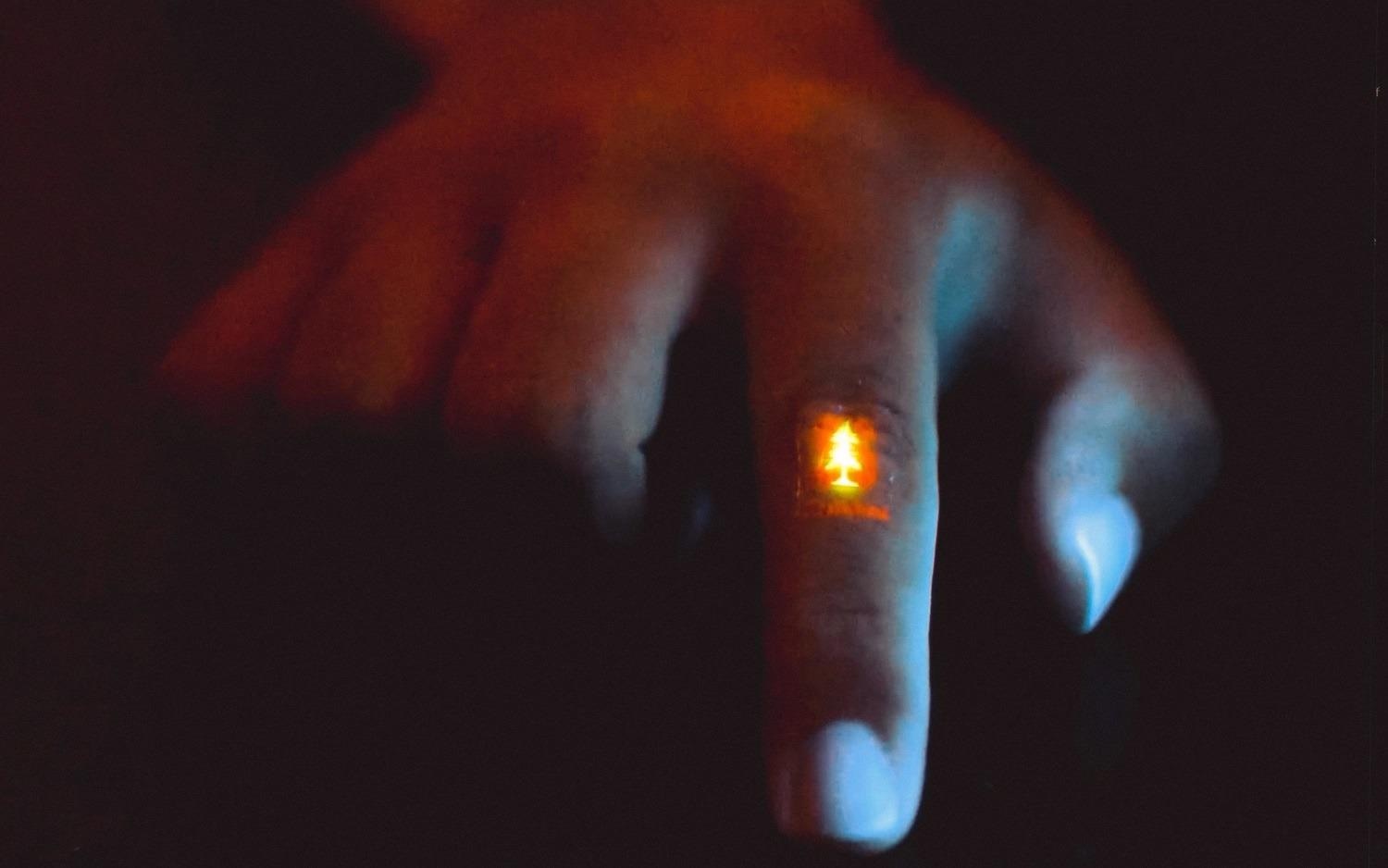Stanford chemical engineers have developed high-brightness, stretchy color displays after uncovering a groundbreaking method of creating an elastic light-emitting polymer.
 Zhitao Zhang wears the flexible light-emitting film, featuring a Stanford logo, on the knuckle of their finger. This shows how the film can hold up to flexing and wrinkling. Image credit: Zhitao Zhang and Jiancheng Lai of Bao Group Research Lab.
Zhitao Zhang wears the flexible light-emitting film, featuring a Stanford logo, on the knuckle of their finger. This shows how the film can hold up to flexing and wrinkling. Image credit: Zhitao Zhang and Jiancheng Lai of Bao Group Research Lab.
It is the worst thing ever for anybody to imagine crumpling up their television, smartphone or another electronic device. The displays available at present are flat, stiff, delicate and thus lack the potential to alter to interactively respond to users.
As part of an overarching hunt to fabricate the so-called “skin-inspired” electronics that are soft and stretchy, a display has been designed by Stanford University chemical engineer to change that. Currently, after more than three years of work, they illustrate the proof of principle toward a stretchy yet potentially reshapable display.
The study was published on March 23rd, 2022, in the journal Nature.
Their invention pivots on the breakthrough of a technique to generate a high-brightness elastic light-emitting polymer, which functions similar to a filament in a lightbulb.
The consequent display of the team has been made completely of stretchy polymers—known as synthetic plastic materials. The device consists of an optimum brightness that is at least two times that of a cellphone and could be stretched up to twice its original length without ripping.
Stretchable displays can allow a new way of interactive human-machine interface. We can see the image and interact with it, and then the display can change according to our response.
Zhenan Bao, Study Senior Author and K. K. Lee Professor, School of Engineering, Stanford University
An Illuminating Discovery
The majority of the light-emitting polymers are stiff and crack once stretched. Scientists can increase their flexibility with the addition of elastic insulating materials, like rubber. However, these additives reduce electrical conductivity, which needs the polymer to utilize a harmfully high voltage to produce even dim light.
However, around three years ago, postdoctoral scholar Zhitao Zhang found that a yellow-colored light-emitting polymer known as SuperYellow was not only soft and flexible but also discharged brighter light when mixed with a kind of polyurethane, a stretchy plastic.
If we add polyurethane, we see SuperYellow form nanostructures. These nanostructures are really important. They make the brittle polymer stretchable, and they make the polymer emit brighter light because the nanostructures are connected like a fishnet.
Zhitao Zhang, Study First Author and Postdoctoral Scholar, Stanford University
Unlike adding rubber, the interrelated net of nanoscale fibers that make the SuperYellow stretchy do not hinder electricity flow. This is the key to developing a bright display. Following this breakthrough, the group also made elastic red, green, and blue light-emitting polymers.
Stacking the Layers
Along with stretchable light-emitting polymers that are available at present, the group wants to layer together with the leftover ingredients of an electronic display.
It was really challenging to figure out the right materials to use. Electronically, they have to match each other to give us high brightness. But then, they also need to have similarly good mechanical properties to allow the display to be stretchable. And finally, for the fabrication, Zhitao had to figure out a way to stack the layers together so that the process will not degrade the brightness.
Zhenan Bao, Study Senior Author and K. K. Lee Professor, School of Engineering, Stanford University
The final display consists of seven layers. Two outer layers are considered as two substrates that encapsulate the device. Moving forward are two electrode layers, each tracked by charge transporting layers. Eventually, the light-emitting layer sits fixed in the center.
When electricity runs via the display, one electrode injects positive charges, known as holes, into the light-emitting layer while the other negatively inject charged electrons into it. When the two kinds of charges come into contact with each other, they get linked and go into an energetically excited state.
Immediately after, the state gets back to normal by producing a photon—known as a particle of light.
The resultant all-polymer film can be joined to an arm or finger and does not rip at the time of flexing or bending. This will enable wearable trackers to have their display straightly attached to the skin.
Bao was able to observe a variety of extra potential uses for a stretchable display. It can be utilized to generate reshapable interactive screens or even develop three-dimensional landscapes on a map.
Bao stated, “Imagine a display where you can both see and feel the three-dimensional object on the screen. This will be a completely new way to interact with each other remotely.”
The additional study co-authors of Stanford in this research include graduate students Weichen Wang, Yu Zheng, Zhiao Yu, and Gan Chen; postdoctoral scholars Yuanwen Jiang, Jian-Cheng Lai, Chengyi Xu, and Donglai Zhong; former visiting scholars Yi-Xuan Wang, and Chien-Chung Shih; former postdoctoral scholars Hung-Chin Wu, Simao Niu and Naoji Matsuhisa.
Former graduate student Yang Wang; research engineer Yilei Wu; assistant director Hongping Yan; laboratory director Jeffrey B.-H. Tok; and Reinhold Dauskardt, the Ruth G. and William K. Bowes Professor in the School of Engineering were also included. The other co-authors of the study are from the Lawrence Berkeley National Laboratory and the University of Mississippi.